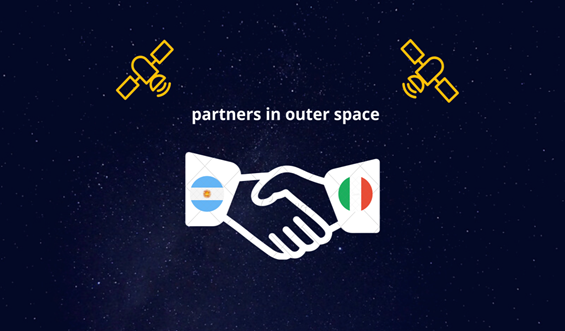Author: Juan Martin González Cabañas – 18/09/2020
This August 30, 2020, the launch (from Cape Canaveral) of the Argentine satellite SAOCOM 1B to orbit was carried out successfully, in this informative dossier we will address the characteristics and implications of this space project that marks a milestone in the Italian-Argentine aerospace technical cooperation.
Outer space: a new strategic chessboard
In a previous publication it was mentioned that the spatial dimension is a new geo-strategic chessboard and therefore the importance of technology in the new geopolitics. It’s curious to observe the dual nature of the space race: both as a field of competition and as cooperation between great powers.
Technological advance will increasingly be a strategic element both for the security and prosperity of the countries. In this sense, the projection of capacities in the spatial field has been synonymous with projection on the international stage in a broad sense.
For this reason, space policy in particular and scientific policy in general must be maintained, financed and promoted from the State as long-term policy and a point of common agreement for all governments beyond their ideological or partisan guidelines.
While the course of the global economy is difficult to predict, all signs seem to indicate that the aerospace industry will be one of the most important of the 21st century. Those countries that do not participate in it will be lagging countries.
In this sense, it is worth highlighting the trajectory made by Argentina with regard to spatial projection, with a great support in its aerospace history [1].
The SAOCOM project
The recently launched satellite 1B is part of the SAOCOM (Argentine Satellite for Microwave Observation) project.
SAOCOM is a system (constellation) of two satellites (the twin of the1B, the 1A was launched in 2018) of terrestrial observation belonging to Argentina’s space agency, CONAE (National Commission for Space Activities). Both are equipped with a 1.275 GHz L-band polarimetric synthetic aperture radar (SAR) and a 35m² deployed antenna.
But the SAOCOM program is part of an international cooperation strategic plan far more ambitious:
SIASGE: the outcome of a strategic Italian-Argentine partnership
Italy was considered as a feasible good strategic partner for the spatial projection of Argentina, because in addition to the deep cultural economic ties and even kinship between the two countries, Italy already had a rich aerospace tradition [2].
SIASGE (Italian-Argentine Satellite System for Emergency Management) is the result of cooperation between CONAE and ASI (Italian Space Agency) .This cooperative relationship was formalized with an agreement between the two institutions in 1992.
These ties have continued to consolidate producing synergy until today, since 1992, CONAE and ASI have collaborated together in the SAC-B and SAC-C projects. Based on this synergy created in 2005, the SIASGE strategic plan was formalized.
The SIASGE System is made up of the 4 Italian COSMO-SkyMed satellites and the 2 SAOCOM satellites (Argentina). This satellite constellation can provide information on the soil, climatic conditions, crops-agriculture, monitoring of natural resources, and surveillance of natural emergencies.
The Argentine authorities have declared that in the near future a new alliance for the manufacture of an additional series of satellites, the SIASGE II could materialize.
Union makes the force
Following the national Argentinian motto, these two countries have used their traditional model relationships, based on economy, culture and even kinship as a vector to achieve synergy in the technological field, in the aerospace sector, strategic dimensions for countries in the 21st century.
SAOCOM data sheet
The satellite weighs 3,000 kilograms, is 4.7 meters high and 1.2 meters on a side. Its service platform consists of three solar panels of 1.51 x 2.7 meters each. It’s deployed SAR radar antenna measures 35 m2 with 7 panels of 1.5 x 3.5 meters that make it up and weighs 1,500 kg. It will orbit 620 kilometers high and will be able to obtain 225 images per day.
| Mission type | Earth-observation satellites |
| Operator | CONAE |
| Manufacturer | INVAP |
| COSPAR ID | 2020-059A |
| SATCAT | 46265 |
| Launch mass | 3050 kg |
| Dry mass | 1600 kg |
| Reference system | Geocentric orbit |
| Altitude | 620 km |
| Inclination | 97.89° |

Footnotes
[1] The SAOCOM 1B is part of a long process and technological tradition:
Argentina at a technological level is one of the members of the exclusive satellite club (countries capable of developing this kind of device). The satellite field is one of the few technological-industrial niches (along with the nuclear-atomic one) that survived the neoliberal decades of the 90s of disinvestment in science and technology, and it is one of the niches in which the country has a remarkable competitive ability.
The dawn of the history of the Argentine aeronautical industry can be traced back to the governments of Juan Domingo Perón (1945-1955), in which the first tests of rocket engines began, using different fuels.
The Argentine spatial vocation would be consolidated during the mandate of Arturo Frondizi (1958-1962). In this period, the first organization in charge of space development was created: the CNIE (National Commission for Space Research) under the supervision of the Argentine Air Force.
During the 1960s and 1970s many launches of aerospace vehicles were undertaken for various purposes, almost always with positive results and with important contributions from Commodore Aldo Zeoli. Argentina drew important world milestones in its astronautical history, such as being the fourth country to take a living being to space and return it alive to earth; in turn it was the third to launch rockets from Antarctica.
The CNIE ended its activities in 1991 (government of Carlos Menem 1989-1999) when the national government created a civil, decentralized and specialized organization dedicated to the peaceful use of space: CONAE (National Commission for Space Activities) that since 1992 is the state agency in charge of carrying out the National Space Plan of Argentina (which establishes Argentina as a “space country”, which expresses its willingness to use and take advantage of space science and technology for peaceful purposes).
During this period, the SAC (Scientific Applications Satellites) series were put into orbit, the first Argentine satellites developed in collaboration with the US NASA and which had a function of terrestrial, climatic and ocean observation and astronomical.
In 2006, the state company ARSAT was created, with the aim of mastering satellite technology aimed at telecommunications. Under this scheme, in 2010 INVAP began to build ARSAT-1, the first geostationary satellite in Latin America, which was put into orbit on October 16, 2014, this was one of the greatest achievements in the history of Argentine technology, since both the satellite and its software were fully developed in the national territory by Argentine scientists and engineers, which made Argentina one of the eight nations with the capacity to produce geostationary satellites.
[2] A country with a long tradition of more than five decades in space projection. The third country to launch a rocket with a satellite on board, the seventh in the world for its investment in space and the third in Europe, a country with participation in many NASA missions to explore the solar system. Also ASI built half of the modules that astronauts inhabit on the International Space Station.
Bibliography
BLINDER, Daniel (2009) “El control de tecnologías duales como poder político-militar. El caso ‘espacial’ argentino” (The control of dual technologies as political-military power. The Argentine “spatial” case)
BLINDER, Daniel (2017) “Argentina en el espacio: política internacional en relación a la política tecnológica y el desarrollo industrial” (Argentina in space: international policy in relation to technology policy and industrial development
Ambasciata d’Italia – Buenos Aires “Cooperación Italia – Argentina: Proyecto SIASGE – Partida del Satélite SAOCOM 1B“
Caleb Henry “Italian and Argentine Space Agencies Renew Collaborative Agreement“, ViaSatellite, 24 May 2016
la Repubblica “Accordo Italia-Argentina per la prevenzione delle catastrofi coi satelliti“, 10 May 2017
Daniel Arias “Italia y la Argentina, socios en el espacio“, La Nacion, 14 March 2001
Lucas Ferrario “La política espacial argentina: ¿por qué es relevante en la actualidad?“, Córdoba Global – Centro de Estudios Internacionales, 28 September 2018
Argentina.gob.ar “Satélite SAOCOM, contribución argentina al sistema SIASGE“
Nora Bär “Con cuatro nuevos satélites, Argentina e Italia vuelven a ser socios en el espacio“, 16 May 2016
Saocom website
Argentina.gob.ar “CONAE – Comisión Nacional de Actividades Espaciales“
Nicolás Cañete “Saocom 1B al espacio: un nuevo hito tecnológico y una mirada al uso de los datos satelitales“, IDB – Puntos sobre la i, 22 July 2020

Juan Martin González Cabañas – Analyst at Vision & Global Trends. International Institute for Global Analyses and Dossier Geopolitico
